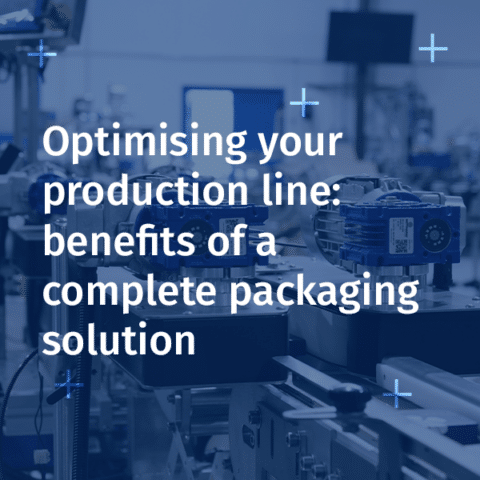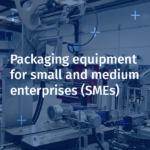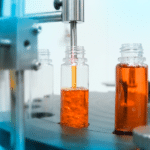In an increasingly demanding industrial context, where speed, efficiency, and profitability are paramount, optimising the production line has become a priority for many businesses. Adopting complete packaging solutions simplifies the purchase, commissioning, operation, and maintenance of machinery. Discover why opting for a complete solution, combining filling machines, capping machines, and labellers, is a strategic lever for improving competitiveness.
1. What is a complete packaging solution?
A complete packaging solution integrates multiple machines and automated processes to perform all primary packaging operations. Unlike fragmented setups where each stage (filling, capping, labelling) is managed separately, a complete (or integrated) solution ensures optimal coordination between each machine, minimising inefficiencies and production downtime.
The key components of an integrated solution include:
- Filling machines: Ensure precise and fast dosing of liquids, powders, or other substances.
- Capping systems: Provide secure and airtight closure of containers.
- Labelling machines: Apply labels quickly and consistently, enhancing brand image.
Additional benefits of an integrated solution
- A single point of contact: You benefit from having one dedicated expert for your needs analysis and overall project management. Purchasing machines from different manufacturers requires adapting each piece of equipment to the constraints of others, leading to time-consuming processes such as explaining specifications, conducting tests, and ensuring compatibility.
- Easier installation and integration: Machines are pre-assembled and calibrated in our workshop, eliminating unexpected issues during on-site installation. For instance, buying a labeller from us and a filler from Italy may result in conveyor mismatches, delayed deliveries, and difficulties connecting the machines correctly.
- Cost reduction for export clients: Choosing a single manufacturer reduces transport and customs costs, unlike purchasing from multiple suppliers. This also simplifies the handling of legal documentation (document submission, letters of credit, etc.), which can be administratively cumbersome.
2. Simplified project implementation
- A single point of contact for requirement analysis and project management ensures no loss of information.
- Comprehensive engineering for a fully integrated line.
3. Easier installation and commissioning
- Machines pre-connected in our workshop: no unexpected issues upon delivery.
- Installation and commissioning carried out by our technicians.
4. Increased productivity on the packaging line
One of the major advantages of an integrated packaging solution is improved overall efficiency. Such a solution optimises workflow and minimises downtime caused by synchronisation errors between different machines.
Key benefits include:
- Reduced handling: eliminates complex transitions between standalone machines and reduces synchronisation errors.
- Time savings: a streamlined and continuous process increases production output.
- Enhanced efficiency: seamless coordination of the different packaging stages.
5. Reduced operational costs
A complete solution helps lower costs, mainly by minimising human errors and reducing maintenance requirements.
- Easier operator training: each manufacturer has its own specificities (touchscreens, settings, etc.). With a complete solution from a single supplier, training is quicker and more effective.
- Simplified maintenance: our machines are designed for easy maintenance, your operators will have the necessary skills to maximise uptime and extend the lifespan of the machines.
6. Guaranteed quality and consistency
Industries must ensure consistent quality to retain customers and comply with regulations. With an integrated packaging solution, each product benefits from precise filling, reliable capping, and uniform labelling, ensuring optimal quality.
Quality benefits include:
- Reduced production variability: each production batch is homogeneous.
- Improved quality control: integrated systems detect anomalies and eliminate defective products.
- Regulatory compliance: modern machines ensure adherence to industry standards.
7. Greater flexibility and scalability
As business needs evolve, a complete packaging solution offers the flexibility required to adapt to production variations.
- Adaptability to different product formats: easily adjustable settings to accommodate various container types and volumes.
- Easy integration of new technologies.
- Scalability: the production line can be expanded with new modules to meet growing demands.
8. Simplified management of export sales
- Optimised transport and customs costs: using a single manufacturer significantly reduces shipping expenses and administrative complexities.
- Easier handling of legal documents: documentation processes such as submission requirements and letters of credit (LOCs) are simplified.
Conclusion
Investing in an integrated packaging solution helps optimise your production line’s productivity. By combining filling machines, capping machines, and labellers in an automated and synchronised process, your business enhances efficiency, reduces costs, and ensures outstanding quality. Additionally, having one single point of contact for all packaging line inquiries simplifies project management.
Choose industrial excellence with a tailor-made, high-performance packaging solution!
Also, check out our article “Why choose a customised packaging solution?”











